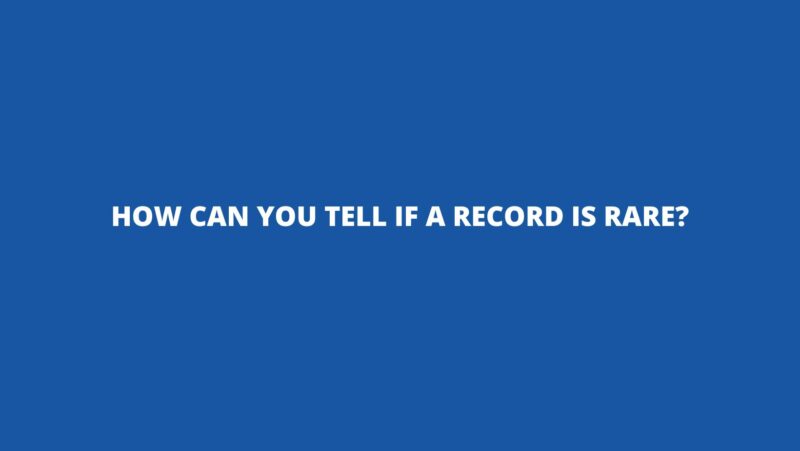The allure of vinyl records extends far beyond their auditory appeal, encompassing the cultural and historical significance that each record carries. Among the vast array of records, the concept of rarity holds a special fascination for collectors, enthusiasts, and music lovers alike. Identifying a rare vinyl record requires a keen understanding of various factors that contribute to its scarcity, demand, and historical context. This article serves as a comprehensive guide to help you navigate the world of vinyl record rarity, offering insights into how to recognize a rare record when you encounter one.
Understanding Vinyl Record Rarity
Rarity in the realm of vinyl records is more than just scarcity; it’s a blend of historical context, production practices, demand, and cultural significance. To truly grasp what makes a record rare, it’s essential to consider the following factors:
- Production Quantity: One of the most straightforward indicators of rarity is the production quantity of a record. Records produced in limited quantities are inherently rarer than those with widespread availability. Look for records that were released in small numbers due to factors like independent labels, limited editions, or regional releases.
- Independent Labels and DIY Releases: Records released on independent labels or through DIY (do-it-yourself) means often have lower production numbers. These releases might be associated with local scenes, niche genres, or emerging artists, making them more challenging to come by.
- Out-of-Print Releases: Records that have gone out of print are typically harder to find, as they are no longer being manufactured. Albums that were released for a short period and then discontinued can become rare if their demand surpasses the available supply.
- First Pressings and Initial Releases: First pressings, which are the initial batch of records produced from the original master tapes, are highly sought after by collectors. These early pressings often have a unique sound quality and are valued for their historical significance.
- Limited Editions and Special Variants: Records released as limited editions with unique packaging, colored vinyl, bonus tracks, or special inserts can quickly become rare due to their exclusivity.
- Promotional and Test Pressings: Promotional copies sent to radio stations, journalists, or industry professionals, as well as test pressings used for quality control, are often rare due to their limited distribution.
- Cultural and Historical Significance: Records associated with cultural movements, historical events, or iconic moments in music history can become rare due to their cultural significance.
- Niche Genres and Obscure Artists: Records within niche genres or obscure artists’ discographies might have limited original distribution, making them rare finds for collectors passionate about those specific genres or artists.
Identifying a Rare Vinyl Record
Identifying a rare vinyl record requires a combination of research, observation, and knowledge. Here’s a step-by-step process to help you determine whether a record is rare:
- Research the Release: Begin by researching the artist, album title, release date, and record label. Use online databases like Discogs, MusicBrainz, and VinylHub to gather information about the record’s production details.
- Check Edition Details: Look for indicators of rarity, such as limited editions, special releases, colored vinyl, or unique packaging. First pressings and early editions are often rarer than subsequent reissues.
- Examine Production Numbers: Research the production quantity of the record. Records produced in smaller quantities, especially for niche genres or independent labels, are more likely to be rare.
- Assess Historical and Cultural Context: Consider the historical and cultural context of the record. Records associated with specific movements, trends, or iconic events might have elevated rarity due to their significance.
- Check Out-of-Print Status: Determine whether the record is out of print. If a record has been discontinued and is no longer available from retailers, it may be harder to find and thus considered rare.
- Inspect the Condition: Examine the condition of both the vinyl and the album cover. Well-preserved records in excellent condition tend to be more valuable, especially when they are rare.
- Research Collector Demand: Explore collector communities, forums, and online marketplaces to gauge the demand for the record. If collectors are actively seeking the record, it may indicate its rarity.
- Consult Experts and Collectors: Engage with experienced collectors, vinyl enthusiasts, and experts in online forums, social media groups, and record fairs. Their insights can help you verify the rarity of a record.
Benefits of Owning Rare Vinyl Records
- Cultural and Historical Significance: Rare records often hold cultural and historical significance, offering a glimpse into specific moments in music history and the evolution of genres.
- Investment Potential: Rare vinyl records have the potential to appreciate in value over time. Collectors often view rare records as investments, especially when the demand is high and the supply is limited.
- Collector Prestige: Owning a rare record is a badge of honor among collectors. It showcases your dedication to music culture and your ability to uncover hidden treasures.
- Enriched Music Experience: Rare records provide an enriched music experience, allowing you to listen to music as it was originally released and appreciated by earlier generations.
Conclusion
Identifying a rare vinyl record is a rewarding journey that involves a deep appreciation for music history, cultural significance, and the nuances of collecting. By considering factors such as production quantity, independent labels, historical context, and collector demand, you can determine whether a vinyl record holds the coveted status of rarity. Owning rare vinyl records not only offers potential financial benefits but also connects you to the artistic legacy of the past, enriching your appreciation for music and the vinyl medium.


